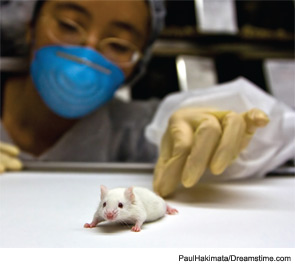
Recently, my laboratory manager came to my office to report on what was happening in the laboratory. She told me about the progress of a number of ongoing experiments and projects that were beginning or that we were just completing. This was a generally optimistic and upbeat meeting, but as she was about to leave, her body language began to shift. Her eyes were downcast and she looked like she was trying to run out of the room. I knew that the news would be bad. Then she told me—the mice that we had been breeding in anticipation of a critical experiment had had their first litter, but there was a problem. The mouse mother had eaten all of the pups, so we would have to start over and the experiment was on hold for another few months.
This disaster was a clear consequence of a decision we had made years before. We had bred our knockout mice onto a common strain of laboratory mice, C57Bl6 mice, so that the genetic background of these mice would be uniform. C57Bl6 mice are known to have a number of immunologic and other peculiarities, but for my lab the biggest problem with C57Bl6 mice is their behavior. These mice are notorious for eating their young.
Mice-Like Men
In addition to animal husbandry issues, there are many obstacles to successful research. Coming up with an interesting and compelling hypothesis to test, designing experiments that fairly test the hypothesis, and executing the experiment are just the tip of the iceberg. The greatest barrier to successful research is, increasingly, funding.
The budget for the National Institutes of Health (NIH) has been flat for several years, reflecting the strains in the federal budget, and many foundations that support research have watched their resources shrink over the past few years so that the percentage of research proposals that are supported is declining. When the percentage of research proposals that gets funded falls (currently 11% of grant R01 proposals are funded by the National Institute of Arthritis, Musculoskeletal, and Skin Diseases) the funding decisions for specific grants become more and more arbitrary and capricious—a grant at the 11th percentile is probably no better than one at the 12th percentile, although both are likely much better than one rated at the 25th percentile.
Rheumatologists, as a group, tend to be detail oriented, critical thinkers with strong opinions, and these same characteristics make them extremely rigorous as grant reviewers.
Peer review has been both the greatest strength and the greatest difficulty in research funding. Review of proposals by a group of scientists with expertise in a specific research area generally results in a fairer distribution of scarce resources and ends up directing research funds to the area where the science is the best. This contrasts with other systems in which a small claque of investigators controls all of the funding (and all of the science); being a member of the club is more important than proposing the best science. So, it seems fair to balance the review groups that rate rheumatic disease research projects with researchers in the area.

